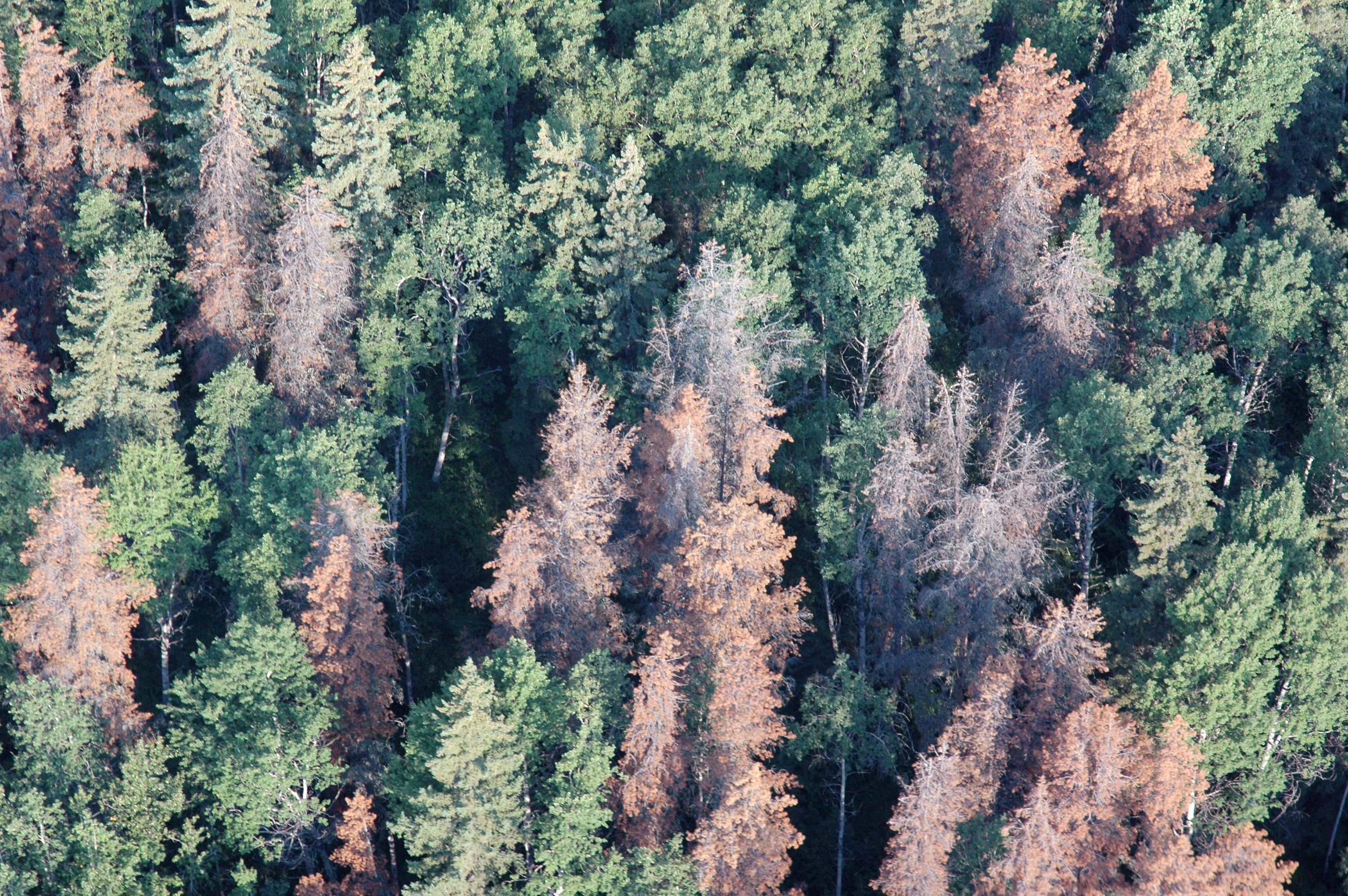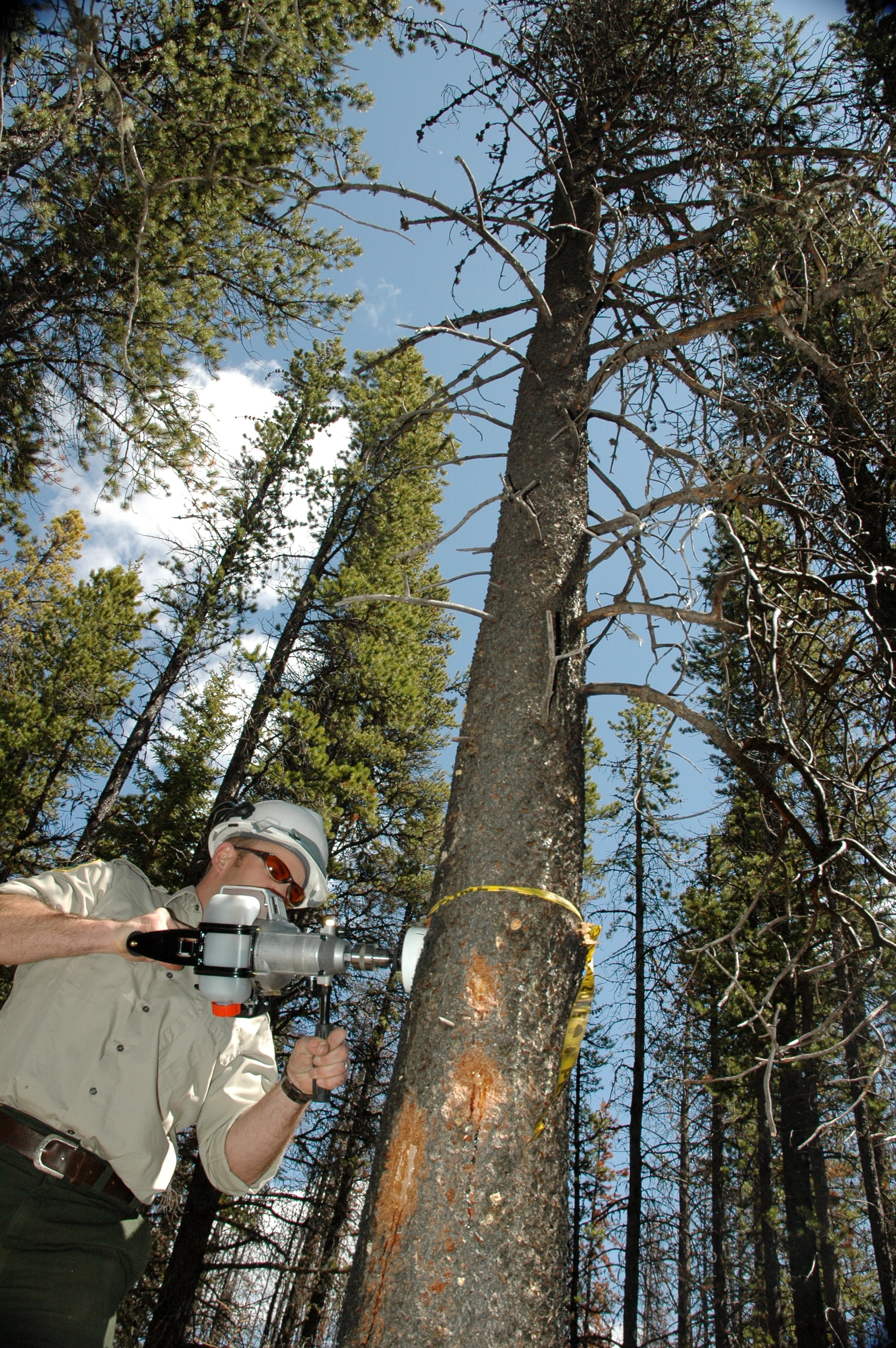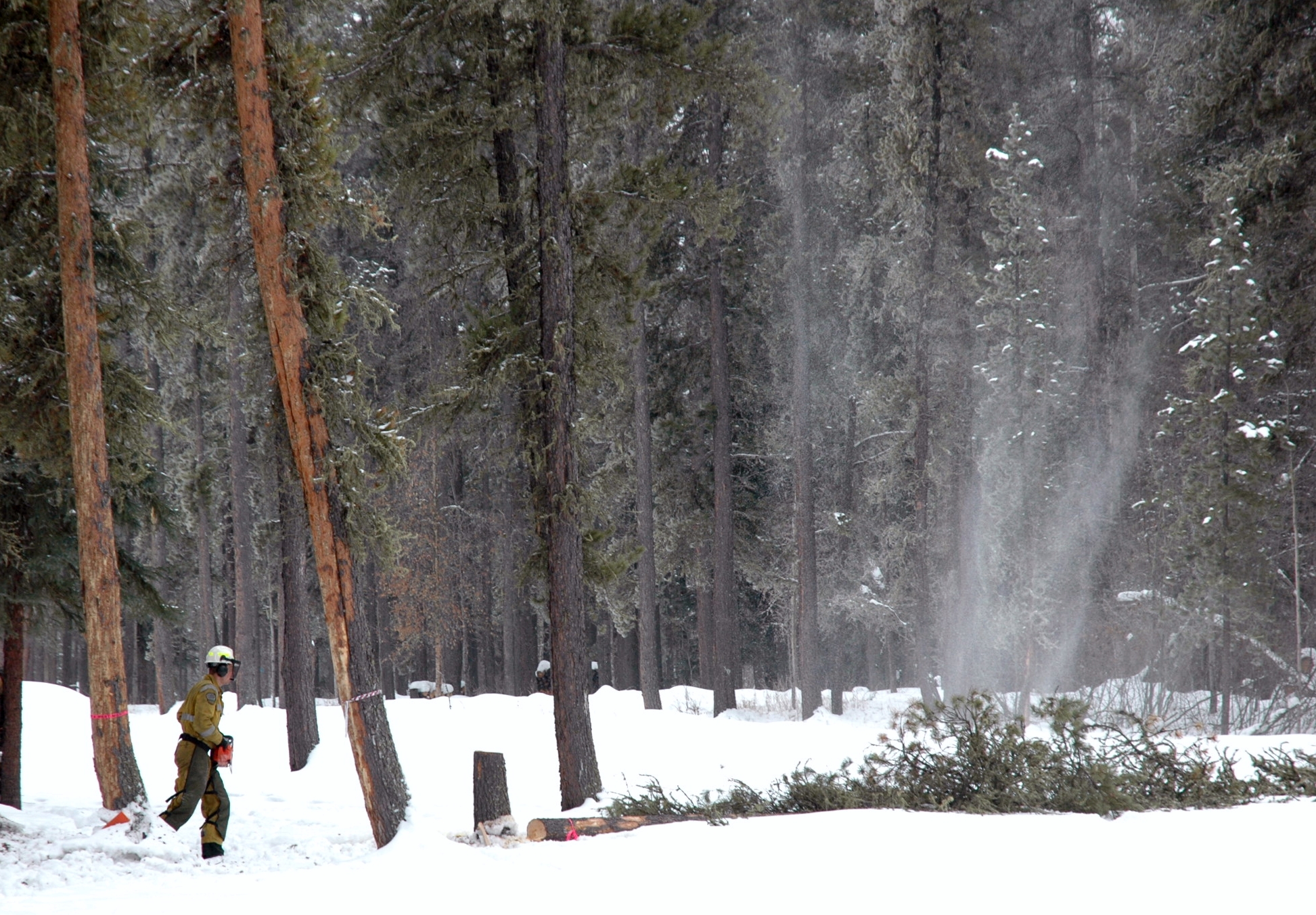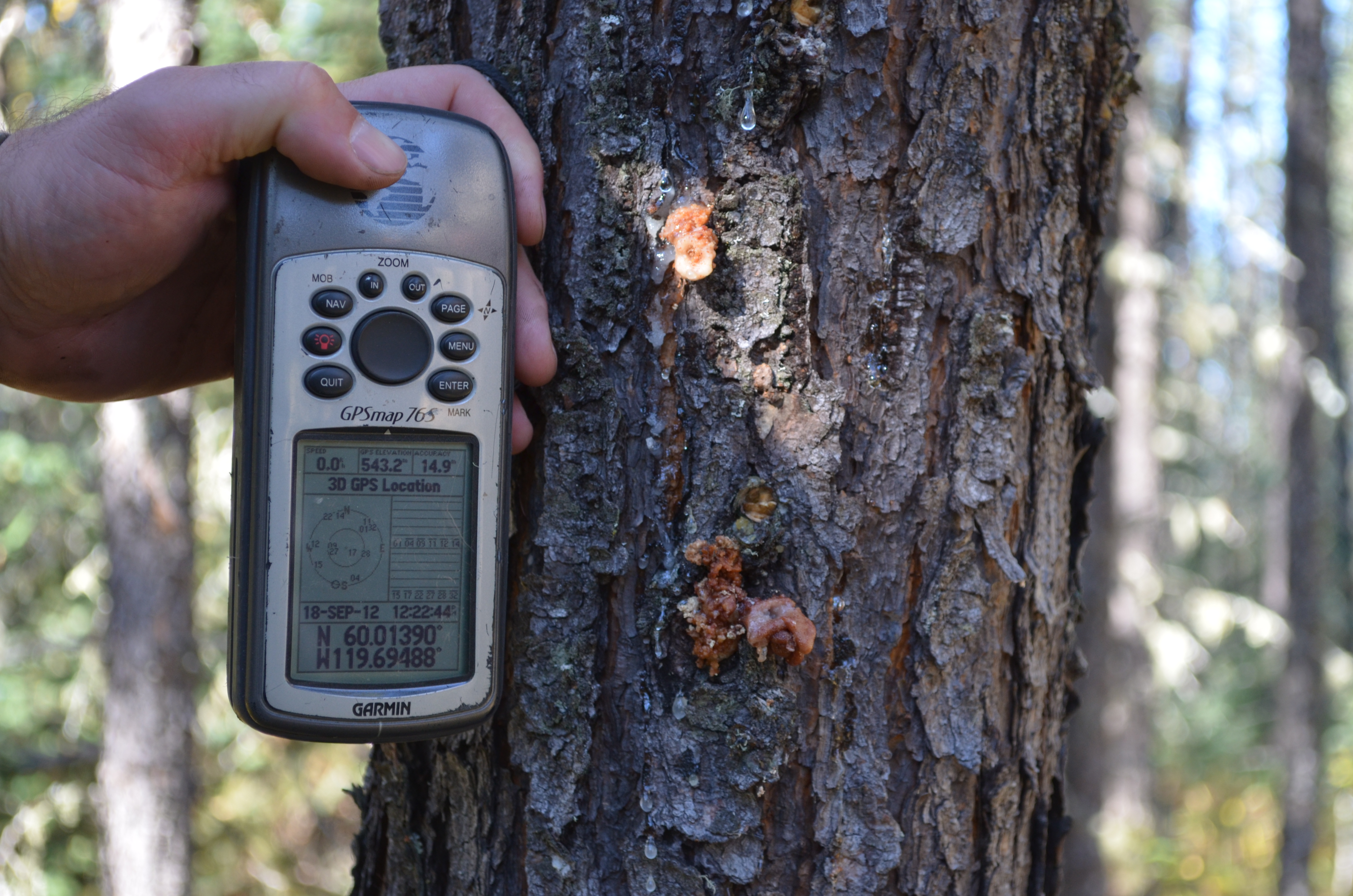
MPB killed lodgepole pine near Grande Prairie, Alberta. Photo credit Government of Alberta, Environment and Sustainable Resource Development.
With the expansion of mountain pine beetle into ranges not seen previously, forest health specialists, researchers and the forest industry have joined forces to share information and suggest options for management.
Mountain Pine Beetle in Alberta
Alberta began managing mountain pine beetle (MPB) in earnest after the occurrence of a large inflight in 2006 that increased the number of infested trees by literally tens of thousands in a single year. Prior to this inflight, less than 1,000 infested trees were detected and treated in Alberta on an annual basis. Due to historical trends, it is fair to say that forest health specialists in Alberta had limited knowledge and experience managing mountain pine beetle on such a large scale. As a result, collaborations and partnerships with forest health specialists and researchers in British Columbia were developed in an effort to fully understand potential impacts, management options, and information gaps. Based on knowledge and advice gained, Alberta wrote the Alberta Mountain Pine Beetle Action Plan outlining the goals and priorities for the Government of Alberta’s MPB management program. Under this action plan, a short-term Beetle Strategy and long-term Pine Strategy were implemented, and the Mountain Pine Beetle Decision Support System – a tool that prioritizes direct beetle control efforts based on biological risk of spread at each beetle site in the province was developed.

Lodgepole pine being sampled to determine over-winter mortality. Photo credit Government of Alberta, Environment and Sustainable Resource Development.
Since 2006, forest health specialists in Alberta have acquired vast knowledge and experience in managing mountain pine beetle populations. Much of Alberta’s experience with mountain pine beetle has been unique because of differences in host/beetle dynamics, climate variations and large influx events (inflights). The management program has remained virtually the same since 2006, but has adapted based on new science, information or trends observed over the past 7 years.
Expansion of Range
In Alberta, the range of mountain pine beetle is slowly expanding to the north, and to the east. Neighbouring provinces and territories have taken an interest in management principles, and new science and information regarding beetle population spread and survival in Alberta. In 2010, with funding from the Canadian Council of Forest Ministers, Alberta hosted a national workshop to provide forest management executives and forest health professionals from across Canada, the chance to experience and discuss the risk of spread, potential impacts and management responses for mountain pine beetle.
Collaboration with other Jurisdictions
Yukon Territory conducted a Risk Assessment Workshop in 2011 to provide stakeholders information regarding mountain pine beetle management in other jurisdictions and potential risks and impacts. Stakeholders were asked to provide ideas on potential impacts to the territories and how beetle infestations may affect them. Alberta forest health specialists were invited to attend this workshop to present on the Government of Alberta’s mountain pine beetle management program.
In 2010, Alberta and Northwest Territories began a joint pheromone monitoring program. In 2012, beetles were detected for the first time in the Northwest Territories through this program. In February of this year, Alberta’s Forest Health Manager travelled to the Northwest Territories where he was asked to share information with forestry executives and forest health specialists on potential impacts, the current program in Alberta and lessons learned to date.
The Alberta-Saskatchewan Spread Management Action Committee (SMAC) was formed in 2010 with a prime objective of supporting mountain pine beetle control to stop spread eastward through boreal pine forests in Alberta, into Saskatchewan and beyond. Work plans benefitting both provinces and meeting each partners’ goals were developed and actions implemented. Although this work was completed in Alberta, Saskatchewan provided funding for actions outlined in the work plan. This work will continue with the development of a 2013/2014 work plan this fall.
The National Forest Pest Strategy has initiated the development of a science-based, national strategic response plan to slow the spread across Canada. This initiative will look at; the current status of mountain pine beetle with recent spread northwards and eastwards, identify factors influencing spread including an assessment of control activity effectiveness, review the latest national MPB Risk Assessment, and build the framework for an operational National Mountain Pine Beetle Management Strategy.
Management of Mountain Pine Beetle
Direct control of beetle populations is a cooperative effort between the provincial government, the forest industry and municipal governments. All three land managers must coordinate treatment efforts in order to successfully treat populations. In Alberta, the provincial government focuses efforts towards Level 1 Control, or single tree treatment of individually infested trees. The forest industry focuses on Level 2 Control, or the harvesting of infested trees through stand-level harvesting. Level 1 and Level 2 plans are coordinated on an annual basis to ensure an effective use of resources that treats as many high risk sites as possible. Municipal governments have the option to apply for a provincial grant that financially supports survey and control work on municipal and private lands.

ESRD crew drops beetle-attacked lodgepole pine near Edson, AB. Photo credit Government of Alberta, Environment and Sustainable Resource Development.
Research
Because Alberta has been outside of the natural range of mountain pine beetle, information gaps exist on issues such phenology, tree host differences, impacts to hydrography and regeneration in effected stands. The Foothills Research Institute (FRI) started the Mountain Pine Beetle Ecology Program in 2007 as a way to address these issues. Together, the government of Alberta, the federal government and the forest industry set research priorities, and communicate these priorities to researchers. Funding to address priorities are available through the Foothills Research Institute and will provide valuable knowledge to land managers on how best to adapt all aspects of mountain pine beetle management now, and into the future.

GPS reading showing a beetle attacked tree north of the Alberta border. Photo credit: Government of Alberta, Environment and Sustainable Resource Development.
Communication, Building Awareness and Education
Communication remains an important element of Alberta’s management program. It is a priority of Alberta’s MPB management program to support our stakeholders by providing them with a well-informed, coordinated and accountable decision making process and ensure they understand what is being done, and how they can contribute to future decisions.
Albertans experience the infestation differently depending on which area of the province they reside, therefore; recent efforts focus on impacts at a regional level. Building awareness assists Albertans to understand the infestation, how it may affect them and provides steps they can take towards mitigating damage to their property and prevent further spread.
Youth outreach and education is done primarily through the education system with strong links into Alberta’s curriculum. Recognizing that mountain pine beetle may become a more prominent national issue, the MPB Communications Team recently translated a publication into French in an effort to extend our reach both within Alberta’s education system, and beyond our borders.
In Summary
The large inflight into Alberta in 2006 created conditions that required a very rapid and coordinated response. Forest health specialists in Alberta responded to this challenge by pulling from their own expertise, and combining that with meaningful input from colleagues and stakeholders within other jurisdictions, industry and researchers.
Management of this forest pest cannot be done successfully by any one land manager or jurisdiction. Collaboration is essential both internally and externally with other government departments, levels of government, jurisdictions and the forest industry. This model of collaboration will continue to be essential with the expansion of range into northern and eastern Canada.
Erica Samis is a Senior Forest Health Officer with the Government of Alberta. She draws on 15 years of experience working in forest health and moved into Edmonton from Hinton in the spring of 2007 to assist the development of a provincially coordinated program. Erica can be reached at [email protected]
Brenda has been involved in environmental education and outreach for over 13 years and currently works with the Government of Alberta to assist with coordination of public outreach and education initiatives. She can be reached at [email protected].
For more information on Alberta’s MPB management program, please visit www.mpb.alberta.ca
- Log in to post comments
